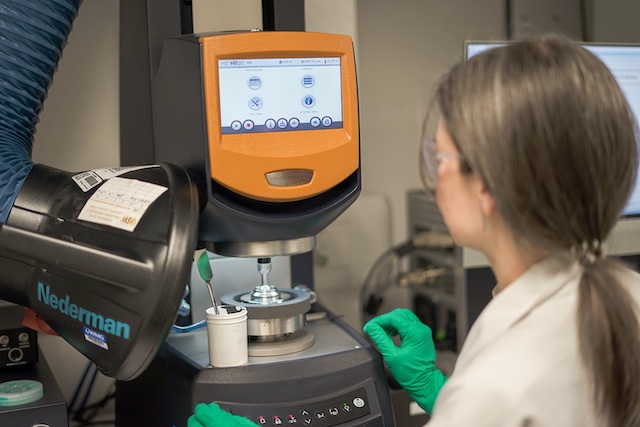WMG Insights
New Roadmap for Lithium-Ion Cell Manufacturing
Dr Mike Lain, Dr Matthew Capener and Dr Mark Copley
Cell Manufacture
Lithium-ion batteries are now widely used in electronic devices and in electric vehicles. Lithium-ion electrodes contain an active material, a polymeric binder, and conductive carbon, coated onto a thin metal foil. Slurry making is the process where the individual components are mixed to form a homogeneous slurry or ink, which can then be coated to produce the electrodes. Overall, the mixing and coating processes have the greatest impact on the quality and performance of the final cells, so optimising this process is vital.

Road-Mapping
As part of the Nextrode project, WMG and partners have produced a roadmap for lithium-ion cell manufacturing. The Nextrode project is funded by the Faraday Institution and is a collaboration between five universities, looking at all aspects of the lithium-ion cell manufacturing process. Published in the Journal of Physics Energy, the roadmap sets out the steps needed to turn ambitions of better batteries into a reality.
Historical Context
Lithium-ion cathodes have not changed significantly since the original Sony battery cells in 1991. The active material is still a layered transition metal oxide, the binder is still PVDF, the coating solvent is still NMP (N-methyl pyrrolidinone), and the foil is still aluminium. The pure cobalt LiCoO2 material has been replaced with a similar material containing cheaper nickel and manganese (LiNi1-x-yMnxCoyO2), and the conductive carbon content has reduced slightly.
In contrast, there have been much bigger changes at the anode. Hard carbon was replaced with graphite, and now graphite plus 5 – 10 % silicon. The PVDF has been replaced with an aqueous binder system; CMC (carboxy methyl cellulose) and SBR (styrene butadiene rubber).
Technical Challenges
NMP is toxic, carcinogenic, and uses more energy to evaporate than water. Therefore, there is a big incentive to change to an aqueous binder system for the cathode. This could be aqueous PVDF, or an alternative binder that has sufficient stability against oxidation at the operating voltage of the cathode. Cathode materials with a high nickel content can be hydrolysed in contact with water, so a surface coating may be necessary e.g., using powder atomic layer deposition (PALD).
Mixing has always been a batch process. A change to a continuous process would reduce processing time, decrease waste, and assist real time process control. Furthermore, increasing the slurry solids content would reduce the energy consumption during drying, and help with thicker coatings. However, the rheological properties of the slurry must still allow uniform coating using traditional methods e.g., slot die coating, or alternative methods like extrusion.
Addressing Challenges
WMG has a wide range of different mixing equipment available in the Energy Innovation Centre, which can be used in research activities to address key electrochemistry challenges. The photographs below show small scale versions of four mixers; larger scale versions are also in use, and all of them can be scaled up to a full-sized industrial process. The latest addition to the range is a twin screw extruder.
Future Prospects
Aqueous cathodes have already been demonstrated, and their performance is only marginally below PVDF / NMP cathodes. The trend towards higher coat weights and lower conductive carbon contents will continue, as the demand for higher energy density remains. Collaborative projects like Nextrode will help to optimise the electrode formulations, the mixing sequence, and the coating conditions. The work will also help to characterise slurries and coatings as intermediate components, to predict their relative performance, rather than waiting to see how the electrodes perform in cells.
The research activities undertaken by WMG and partner Universities, will enable enhanced quality and better performance for future batteries, and therefore for the products that use them such as electric road vehicles. WMG’s equipment and expertise will be used to help battery manufacturers to develop their cell chemistry and evaluate battery materials from potential suppliers. Large-scale UK-based quality battery manufacture will be vital for the future of the UK automotive industry.
Further Information
Find out more about the Nextrode project at Next Generation Electrodes - NEXTRODE | Next Generation Electrodes (ox.ac.uk)
Acknowledgement is given to the Faraday Institution and to the High Value Manufacturing Catapult (HVMC) for their support to WMG’s research.
Read WMG’s contributions to the Technology Roadmap at Roadmap on Li-ion battery manufacturing research - IOPscience WMG contributed sections on UK Strategy (Prof. D. Greenwood), Modelling & Machine Learning (M. Faraji-Niri & J. Marco), Design of Experiments (L. A. Román-Ramírez & J. Marco), and Slurry Making (M. J. Lain, M. J. Capener & M. Copley).

